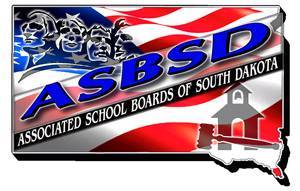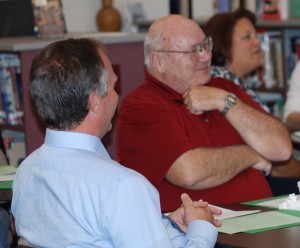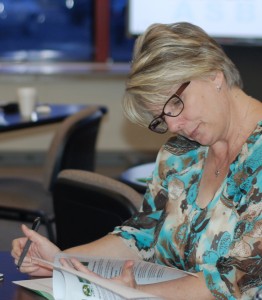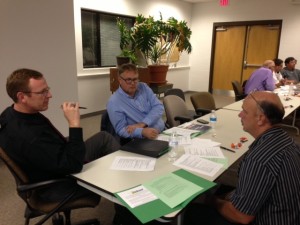The potential for a major shift in three aspects of K-12 funding dominated discussion at the recent ASBSD Region Meeting in Brookings, as it did in Beresford the night before and as it is expected to at each subsequent meeting.
At the Brookings meeting, representatives from 11 school districts were presented with potentially landscape-shifting changes that have been discussed to capital outlay, other revenue and teacher pay by ASBSD Executive Director Wade Pogany.
Pressure from property tax payers about growing capital outlay property tax levels has resulted in the Daugaard administration forming a committee consisting of representatives from the administration, legislators, members of the agriculture community and individuals from the K-12 community, including Pogany.
Pogany said the group has met a handful of time since the conclusion of the 2014 legislative session to discuss the capital outlay levy’s growth, which is on a dollar for dollar levy with property valuation.
On Thursday, Oct. 9, the group is expected to be presented a proposal that will consist of the following options, or something similar:
- Freeze each district’s capital outlay levy. Those with levies under $1.50/$1,000 would have the option, if needed, to raise to a maximum of $1.50/$1,000; all others would be fixed at their current level thus establishing a base.
- Capital Outlay budget growth would be limited to 3% or inflation whichever is greater, plus new construction growth. Inflation has been estimated at an average of approximately 2.5% per year and the statewide average of new capital outlay growth is at1.4%. Therefore, capital outlay growth would be limited to an estimated 4 to 4.5%.
- Legislation would be written to allow districts to seek an opt out from the capital outlay levy base limitation, similar to the mechanism currently in place in the general fund levy.
- Half of the savings from the capital outlay levy limitation would be returned to a school district’s general fund.
- For example, at a 3% capital outlay levy growth limitation, plus new construction, tax payers would save approximately $200 million statewide over the next 10 years. If schools received half of that savings, or $10 million per year for 10 years, it would provide schools with approximately $75 per-student in ongoing dollars that would be added to a district’s general fund. This would be a 1.5% increase one time in state aid.
Pogany said discussion continues on the proposal, but added that legislation is likely to be presented and districts need to be prepared to discuss the option with their legislators.
ASBSD will provide updates on the proposal following the Oct. 9 meeting as they become available.
Along with news of capital outlay’s potential change came discussion on two pieces of legislation that proposed changes to the distribution of other revenue to schools districts.
Pogany shared two pieces of legislation introduced by Rep. Dan Dryden during the 2014 legislative session – both of which were defeated.
One proposal called for the equalization of tax revenue from wind energy and bank franchise taxes and the gross receipts of telephone companies and electric co-ops. Currently, state law calls for any revenue collected from the taxes to be distributed to districts within the county it’s collected. The proposal would evenly distribute the revenue collected to all South Dakota school districts.
A “hold harmless” clause would establish a revenue base for districts to receive based on the first year of the equalization plan. Any revenue collected above the base level set in the first year would be distributed to all school districts.
The second proposal dealt with the distribution of fine money, which is collected by the county and distributed to the school districts within. The state constitution prevents revenue from fine money from being redistributed therefore the revenue received would be calculated in a district’s local effort portion of the state aid formula.
ASBSD opposed both bills during session based on the Association’s resolution C6 Other Revenue, which supported the notion of keeping other revenue within the district that received it.
“It takes new growth and equalizes it,” Pogany said of the proposals, adding that each is likely to be introduced again in 2015 and may have the support of the Daugaard administration.
Finally, region meeting attendees reviewed and discussed a proposal introduced by ASBSD, SASD and the South Dakota United School Association to improve teacher pay.
Dubbed the Teacher Salary Enhancement Fund (TSEF), the proposal calls for an additional penny increase from June-August to the state’s sales tax and revenue generated from the tax is estimated at $40 annually, or $4,000 per teacher.
“We have gotten a lot of traction in the public out of this proposal,” Pogany said. “That’s what we wanted.”
Dollars from the fund would be appropriated annually, in addition to state aid dollars, to districts to enhance teacher pay based on the following conditions:
- A reserve balance of 40 percent or less that of its general fund. Districts with a reserve above 40 percent as of June 30, 2015 are eligible to receive TSEF dollars if they reduce their reserve to 40 percent or less by June 30, 2019. Districts must annually reduce their reserve by ¼ the amount above 40 percent each year from 2015-19.
- Districts must agree to increase their minimum base salary by three percent annually for three years beginning in 2015-16. If a district’s minimum base salary is under $32,000 in the 2014-15 school year it is eligible to receive additional funding if they annually increase the minimum base salary by 1/3 the salary difference from $32,000.
- If the PSA increase is above two percent, half of the funds from the percentage above two percent (e.g. if districts receive a 2.5 percent increase, half of the dollars from the .5 percent) must be put towards teacher salaries.
“The proposal creates conditions by which school districts have to meet to receive the money,” Pogany said. “These conditions did not come about randomly. These are things we’ve heard legislators discuss.”
The proposal would also allow the school board of a district to provide teachers with a signing bonus, moving expense, college loan payment or other market-based resources as they see fit, which resulted in a new resolution to ASBSD’s legislative platform.
Expect these discussions to continue and possibly evolve as the region meetings roll on. Dates for future meetings include:
- 10/7 – Lead-Deadwood School District (Lead-Deadwood Middle School Multi-Purpose Room in Lead – 234 South Main)
- 10/8 – Douglas School District (Douglas High School Commons Area in Box Elder – 401 Tower Road)
- 10/9 – Eagle Butte School District (Eagle Butte Upper Elementary Conference Room in Eagle Butte – 24 West Prairie Road)
- 10/14 – Aberdeen School District (District Service Center Conference Room in Aberdeen – 1224 3rdStreet South)
- 10/22 – Bon Homme School District (Bon Homme Ag Education Classroom in Tyndall – 1404 Fir Street)
Please note: the meeting scheduled in Sanborn Central on Tuesday, Oct. 21 has been cancelled.
The meetings are scheduled to run from 6:30-8:30 p.m. with a meal served at 6 p.m. There is a $15 fee and registration is required to provide a count for the meal provided before each meeting. Registration cancellation must be made 72 hours prior to the meeting or a $10 fee is incurred.
Please contact your district’s business manager to have them register you for the meeting in your area.




